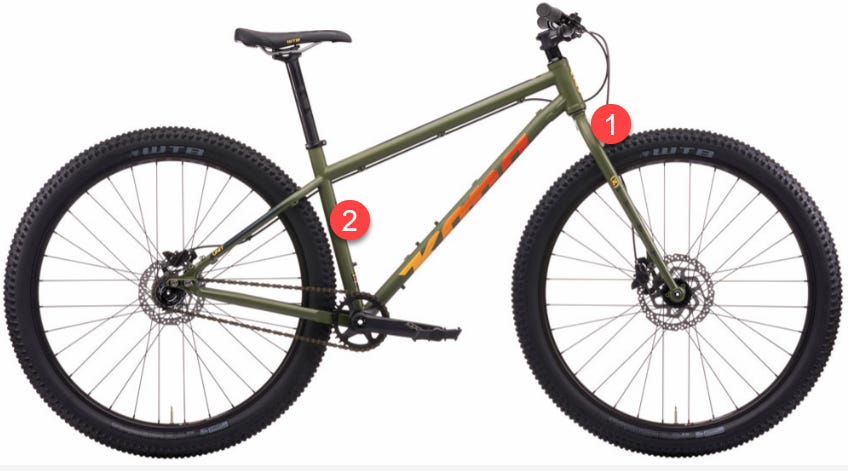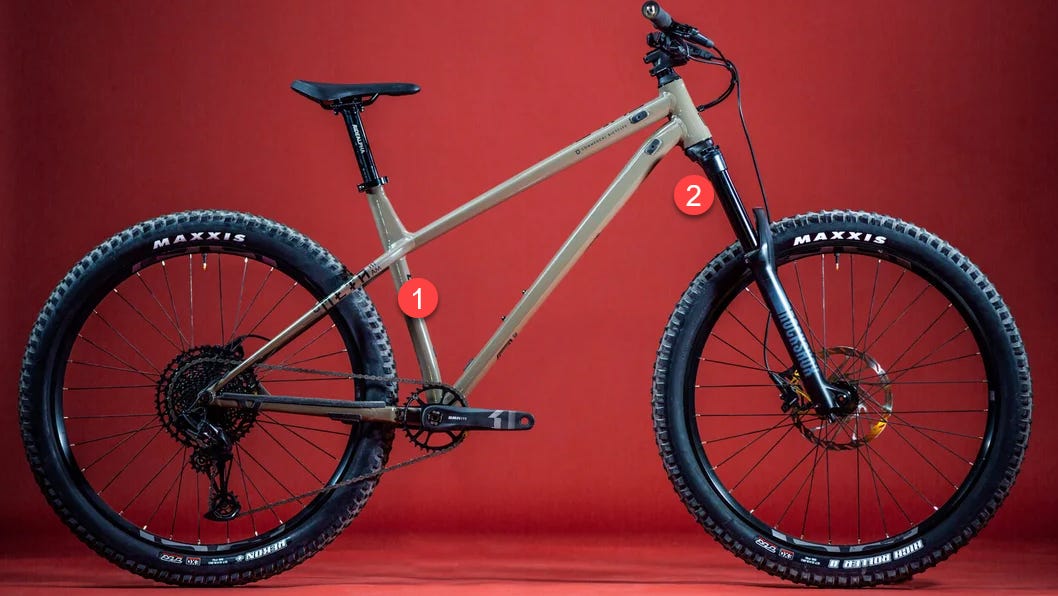What is a Mountain Bike?
First, let’s address what a mountain bike actually is, relative to other bike types. For some of you, this might be new information. If not, feel free to skip this and read on.
A mountain bike is a type of bicycle specifically designed for off-road riding on rugged and unpaved terrains. Compared to other bike types, such as road bikes or hybrid bikes, mountain bikes typically feature wider and knobbier tires, a more robust frame construction, and suspension systems that are specifically designed to absorb the impact of rough terrain.
Overall, a mountain bike is designed to handle the unique demands of off-road riding and provide riders with the necessary tools to tackle rough and challenging terrain.
NICA RULES
The League we race in, and the national body that governs our racing rules defines a mountain bike generally as a bike with the following qualities:
Tires must have knobbies (no smooth/slick tires are permitted)
Must have mountain bike handlebars - no drop bars are allowed.
Tires must be a least 1.75 inches wide or wider.
Wheels must be between 26-29 inches (any smaller must be approved based on physical needs, etc)
No single speed bikes (you must have at least 5 gears in the rear)
Must have functioning rear and front brakes (no pedal brakes or single end brakes)
All shops will know the difference between what is acceptable and what is not, in terms of what is a mountain bike and if you reference NICA, they will guide you properly.
How We Categorize Mountain Bikes
There are a large variety of mountain bikes out there, and they are NOT all the same quality, aren’t always the appropriate type of mountain bike for you, and there is also a wide range of experience (preference) and cost considerations. This guide will give you some of the basics for understanding the core types of mountain bikes that are relevant to 90% of people, including those of you riding and racing cross country.
Here is basically how this guide will break down bikes:
Beyond that, there is more to know about mountain bikes, but this will give you the most important and large categorizations..
Suspension Type
The first major category mountain bikes are broken into is by the type of suspensions they have. There are three main categories of mountain bike suspensions: rigid, hardtails, and full-suspension.
Rigid bikes have no suspension.
Hardtails do not have a rear shock and have either a suspension fork or a rigid fork.
Full-suspension bikes are defined by having both front and rear suspension.
Rigid Bikes
Rigid bikes are just that. Rigid. They have no suspension built into the bike. Notice the image below - there is no front suspension (#1) or back suspension (#2). There are certainly some people who like the challenge of a rigid bike, but it is NOT recommended for most riders, as the quality and comfort of ride, as well as it’s ability to handle rough terrain is much more limited - it is highly dependent on the rider’s skill to navigate rough terrain with technique and strength. The upside of a bike like this is that they are going to transfer power to the bike from pedals very efficiently because no power will be transferred or absorbed by a suspension.
Hardtail Bikes
Below is an example of a hardtail. Notice that while it has a front suspension (#2), it has no suspension in the back(#1), leaving the “tail” rigid, or “hard” - thus the name, hardtail.
Hardtails are great, and many pros still ride them on some race courses, depending on the course requirements for technical riding, and personal preference, etc.
Advantages of a hardtail are:
Generally lighter
Generally cheaper (no need to pay for extra frame component or suspension)
Easier to maintain - no rear suspension to worry about.
Disadvantages of a hardtail are:
More rigid in the back means it will
Full Suspension Bikes
Full suspension bikes are just what they sound like - they have a full set of suspension: front and back. See the image below. This is one example. Notice that it has a suspension (#1) in the front fork, and one in the back (#2).
Bike Purpose/Usage Type
We also categorize bikes by usage type - in other words, their primary ride style or purpose. While there are several categories for this, we generally consider the following four:
Cross Country (XC) mountain bikes
Trail mountain bikes
Enduro or all-mountain mountain bikes
Downhill & freeride mountain bikes
Let’s look at each one:
Cross Country Mountain Bikes
Cross country mountain bikes are built for riders who want pedaling performance as their top priority. These are uphill crushing, lung-busting machines bred for endurance and efficiency. The geometry of cross country bikes is the most similar to road bikes. The focus on efficiency and lightweight doesn’t come without tradeoffs, however, cross country bikes trade out downhill performance for efficiency and weight. Cross country mountain bikes are great for riders that are going to put in long miles pedaling, and those who prioritize climbing over descending.
Modern XC bikes are trending towards the largest mountain bike wheel size, 29”. This is the same rim diameter as the 700c road bike size.
Ultra-lightweight builds (less than 24 lbs. in some cases) with 4.7"/120mm or less of travel make for the lightest mountain bikes you’ll see anywhere.
Hardtails (front suspension only) can be preferential in this category in some cases.
Longer chainstays & wheelbases, steep head angles (69° or steeper) as well as longer stems put riders in efficient climbing positions.
Tires on these bikes are likely to favor reduced weight, efficiency and faster rolling resistance rather than traction, control or durability.
Trail Mountain Bikes
This category is what most people relate to when they think “mountain bike.” Trail bikes are the Swiss army knives of mountain biking and are both great climbers and capable descenders. Trail bikes add more suspension, more gravity oriented components (like chunkier tires for better traction and bigger brake rotors), and more relaxed geometry than their XC brethren to make them more capable on all kinds of terrain. Do you see yourself on all-day backcountry epic rides as well as banging around town and your local trails? Do you measure your rides in grins and smiles rather than seconds? If you’re into mountain biking uphill just as much as downhill and are looking for the occasional drop or jump, a trail bike is probably what you’re looking for.
Trail bikes come with 27.5” or 29” wheels. Suspension can be anywhere from 4.7"/120mm to 6"/150mm of travel (front and back).
Trail bike geometries are typified by "neutral" head angles (66° or 68°) but vary widely to suit different riding styles.
Tires on trail bikes will strike a balance between durability, traction and rolling efficiency.
Enduro or All-Mountain Bikes
You could call this category the burly cousin of the trail bike. all-mountain bikes are the centerpiece of the race format called “Enduro,” where climbing is necessary, but only the downhill sections are timed and scored on. An all-mountain or enduro mountain bike is the perfect rig if you’re willing to earn your ride by pedaling up, but are really in it for the downhill with technical terrain and airtime in mind. That being said, if you want to skip the pedaling and do a couple of laps at a bike park or even some shuttle accessed terrain, an all-mountain bike can handle that too.
Enduro mountain bikes come with 27.5” or 29” wheels, or even mixed “mullet” sizes with 29” in the front and 27.5” in the rear.
All-mountain bikes have slightly more suspension travel than trail bikes, ranging from 5.5"/140mm to 6.7"/180mm.
Geometry strongly favors descending to climbing. Head angles in the 65°- 67° range can require some finesse when it comes to steep climbs.
Long wheelbase and reach, low bottom bracket and slack head angle are key terms when talking about modern all mountain/enduro geometry.
Tires on all mountain bikes are likely to favor aggressive knobs for cornering and traction since the important part of the ride is gravity assisted.
Downhill & Freeride Mountain Bikes
Downhill bikes are designed for steep, gnarly terrain, speed, big drops, and jumps. With these bikes, you’re usually looking for some other way to the top of the trail whether that’s hiking, shuttling or a chairlift. They simply aren’t made to go any direction but down. If you’re not even remotely interested in pedaling uphill, have the trails & terrain to support high speeds and airtime, and the skill level to handle yourself in these situations, a downhill bike is what you’re looking for.
Burly frames sporting 6.7"/170mm - 10"/250mm+ of suspension travel in the rear and 7"/180mm - 8"/200mm in the front with dual-crown forks that resemble something you might see on a motorcycle.
These bikes tend to be extremely slack (less than 65° head angle) and sport a very low center of gravity (bottom bracket) for confidence on steep terrain and aggressive, brown-pow roosting corners.
Tires on downhill bikes are geared for traction and durability with 2-ply (think double-thick) casings for traction and durability.
Frame Material
We can also look at bikes in terms of the material their frames are made of. While this is really a sub-category within the other categories, it’s an important component of cost, experience, weight, etc.
For most mountain bikes, the options are generally simple and entail one of three material types:
Steel
Aluminum alloy
Carbon fiber
Different materials have different ride characteristics and weight, and while steel frame bikes can be fun, it’s a lot like a rigid frame bike - usually it’s a bike you buy when you are more advanced and can handle the extra weight. We DO NOT recommend a steel frame bike for kids learning and racing mountain bikes (especially in cross country).
This means that 99% of the time, you are considering either aluminum or carbon fiber for your bike. So let’s consider that choice and what it means.
Carbon vs Aluminum Mountain Bikes
Each of these materials is a great option for bikes. Each has their advantages and disadvantages and the tradeoffs that come with choosing one over the other.
On a basic level, carbon fiber is lighter and stronger, but more fragile and expensive.
Aluminum is cheaper and more durable, but heavier.
As far as the quality of the ride, carbon fiber is damper and more torsionally stiff.
Choosing a frame comes down to deciding which of these factors above are most important to you.
The last consideration really is another subcategory, but an important enough factor that we will describe it here. That is by drive train (gearing) type.
Drivetrain/Gearing
Bikes have two main “cassettes” or sprockets or chain rings that drive the bike when you pedal. You have the rear cassette and the front chain ring.
Front Gear
The
A 2x drivetrain has two chainrings and a front derailleur, whereas a 1x drivetrain forgoes a front derailleur and uses a single chainring.
1x drivetrains save some weight because they have fewer components, and there is also no need for a gear cable or electrical wire to route from the shifter.
1x chainrings often feature a ‘narrow-wide’ profile where the teeth alternate between narrow and wide, to better hold the chain.
The rear derailleur on 1x drivetrains will often feature a clutch mechanism, which increases the weight of the component, to help retain the chain and stop it slapping on the driveside chainstay.







